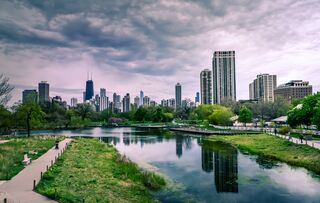Law and Crime
Can Green Spaces Reduce Violence?
New study suggests homicide rates in cities go down as greenery grows.
Posted September 23, 2021 Reviewed by Chloe Williams
Key points
- Nature helps reduce stress, restores cognitive capacities, and increases people's physical and mental health, according to research.
- Nature may also help reduce violent crime. The greener a city is, the fewer homicides it saw over a 30-year period, a new study shows.
- Nature's soothing effects may help revive self-control and dial down intense emotions that lead to aggression and violence.

A wealth of research confirms what many of us know from being near trees, parks, and outdoor spaces: Nature helps soothe us and reduce stress, restores our cognitive capacities, and increases our physical and mental health. But can nature have an impact on crime—specifically, violent crime? Michigan State University's Jonnell C. Sanciangco recently led a team of researchers to answer this question by seeing whether increases in greenery in the United States predicted fewer homicides over a 30-year time period.
Does Greenery Reduce Crime?
Sanciangco's team obtained FBI data on murder and non-negligent manslaughter from 290 American cities within 45 different states between 1986 and 2015. They also reviewed census data from each city to compile variables that risked confounding any association between city greenness and homicide rates, to control for such factors when statistically analyzing them. These variables included population density, percentage of individuals without high school diplomas, percentage of unemployed individuals, percentage of single-mother households, and percentage of people living in poverty. Prior research suggests each factor predicts higher crime.
The researchers also gathered data on climate change (measured by temperature) since higher temperatures have been associated with higher rates of aggression and violent crime. This variable was also controlled for.
Lastly, Sanciangco's team measured each city's level of greenness from the 1990s through 2015 via the normalized difference vegetation index (or NDVI), which measures reflections of visible and infrared light across regions (since healthy vegetation absorbs more visible light and reflects more infrared light than unhealthy or sparse vegetation).
What the Study Found
As published in the September 2021 edition of Environment and Behavior, Sanciangco's team saw declines in homicides from 1990 to 2015 in 218 cities. Washington, D.C.; Atlanta, Georgia; and Richmond, Virginia saw the most significant declines. By contrast, Pittsburgh, Pennsylvania; Salinas, California; and Baton Rouge, Louisiana saw homicide levels increase during this time. Higher homicide rates were concentrated primarily in the East South Central region of America (which includes Kentucky, Alabama, Mississippi, and Tennessee) with 77 deaths per 100,000 persons while the Mountain region (Montana, Idaho, Wyoming, Nevada, Colorado, Utah, Arizona, and New Mexico) saw the lowest homicide rates (with 25 deaths per 100,000 persons).

Over half of all cities studied slightly increased their average greenness from 1990 to 2015 by just under .05 NDVI. Decreases in greenness (under .05 NDVI) were observed in 87 cities. The most significant greenness gains occurred in Anchorage, Alaska; Honolulu, Hawaii; and Brownsville, Texas. Gilbert, Arizona; Chandler, Arizona; and Fargo, North Dakota experienced the biggest declines in greenness.
Upticks in greenness appeared to correlate with declining homicide rates, with every .01 unit change in average greenness (measured by NDVI) predicting .30 fewer deaths per 100,000 persons in a given area.
Homicide rates also correlated with greater proportions of the population not having a high school diploma and being below the poverty line. Interestingly, population density, unemployment, prevalence of single-mother households and increased mean annual temperatures did not.
How Greenery Might Reduce Violence
Because nature can help calm us, it holds a small but not insignificant power to dial down hot-headed emotions that can lead people to physically aggress. Exposure to nature can also prompt people to shift their perspectives by reminding them of their place in the larger scheme of things—and providing space and time to reflect on the consequences of actions they may take in heated moments. The inherent beauty of natural phenomena can also distract people from impulses or plans to harm others. (This may all sound a bit woo-woo but next time you're about to lose it on someone, see how much less likely you are to berate them after quietly strolling through a park or garden.)
Sanciangco et al. argue that nature's known restorative effects on cognition help revive self-control—the linchpin of whether we lash out or let negative emotions overwhelm us. More collective self-control among a city's inhabitants could mean a lower likelihood of violence.
Sanciangco's team also proposes that the more pleasant an environment is, the more people living near it will want to protect it, which makes them more likely to surveil, report or try to quash any behavior that undermines a beloved area's sanctity. Greater efforts paid towards maintaining order will lead to a reduction of crime, they argue. Increased greenery may inspire residents to more firmly defend their neighborhoods' safety or integrity.
Applying the Findings
If you're feeling worked up and want to curtail your risk of doing something you'll later regret—or something that could get you arrested—try getting yourself to a greenspace ASAP. You might also consider "front-loading" the self-control-boosting (and anger-reducing) benefits of nature by scheduling a walk through a greener area shortly before a stressful interaction with someone known to push your buttons.

Unfortunately, not everyone has equal access to nature. Green spaces are woefully less abundant in poorer neighborhoods, which tend to see higher crime rates than affluent regions. Increasing green spaces in poorer neighborhoods and helping people living below the poverty line to more easily access parks, gardens, and other natural spaces is critical to the mental and physical wellbeing of all of us. (How about free or discounted entry to botanical gardens for folks below a certain income threshold? More community gardens? These problems are not insurmountable to solve.)
If nature isn't as accessible to you, consider bringing more plants into your home or adorning the walls of your bedroom, workspace, or the background of your phone with nature images—which have also been found to relax us. A quick glance at a forest or rolling hillside could be the reason you choose taking a breath over satisfying an impulse to react aggressively.
References
Sanciangco, J. C., Breetzke, G. D., Lin, Z., Wang, Y., Clevenger, K. A., and Pearson, A. L. (2021). The Relationship Between City “Greenness” and Homicide in the US: Evidence Over a 30-Year Period. Environment and Behavior. Advanced online publication. https://doi.org/10.1177/00139165211045095




